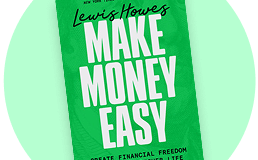Are there things in your home that are hard for you to let go of?
Let’s face it — we all own some items that are no longer supporting us, and the more of those things we have the easier it is to get distracted by all the clutter. What if we could let go of those things that don’t support us anymore? It can help us have more energy, more clarity, and more focus.
Welcome back, everyone. Today’s guest is Joshua Fields Millburn. He is a New York Times bestselling author and host of the popular Netflix documentary, Minimalism. In this episode, we discuss the benefits of minimalism and organizing your life, the five stages of hoarding, how to heal your relationship with money, the best minimalist budgeting tips, and so much more. It’s an exciting episode, so buckle up, and let the class begin.
Who Is Joshua Fields Millburn?
Joshua Fields Millburn is an international speaker, a writing instructor, and a bestselling author of four books, including the globally-acclaimed, Everything That Remains: A Memoir by the Minimalist. His latest book, Love People, Use Things: Because the Opposite Never Works, was released in July 2021 and became an instant New York Times bestseller. Joshua and his wife, Rebecca, founded in January 2021, How to Love, a podcast about parenting, sex, and relationships.
Together with Ryan Nicodemus, Joshua Fields Millburn founded the Minimalists, which has helped more than 20 million people to live meaningful lives with less through podcasts, books, their website, and Netflix films. The Minimalists have been featured in Forbes, Wall Street Journal, Time, Boston Globe, USA Today, Chicago Tribune, Vancouver Sun, Seattle Times, LA Weekly, Toronto Star, San Francisco Chronicle, The New York Times, and many other publications.
Joshua and Ryan teamed up again in 2019 to produce their second Netflix production, The Minimalist: Less Is Now, which is another original documentary about starting over with less. The Netflix film was released worldwide in January 2021.
We’ve had Joshua here at The School of Greatness on episode 407, “Living With Less: The Power of Being a Minimalist,” and our discussion was so powerful that I had to have him back on the show to delve more into the benefits of minimalism to organize your life.
How Minimalism Can Help You Organize Your Life
We live in a world where it seems like there is never enough time. We are constantly juggling work, school, friends, and family life to make sure we can do everything possible for everyone around us. It’s easy to feel completely overwhelmed by the number of things you have on your plate. But what if I told you that minimalism could change your life?
Minimalism is all about living with less clutter in order to clear out mental space and focus on what really matters most. With more free time and clarity, you’ll be able to tackle anything!
“As you look around your house and you have a ton of external clutter, [there’s] nothing wrong with that — nothing evil about that [and] no shame in it. But it’s probably a sign of a lot of internal clutter — mental clutter, psychological clutter, spiritual clutter, relationship clutter, career clutter. There’s all this clutter that’s going on inside us, and it manifests outwardly because we think we have this void. … What we try to do is we fill [this void] with stuff, so it’s really about healing our relationship with stuff.” – Joshua Fields Millburn
We often create relationships with things in our possession, and sometimes it can be hard to get past the idea of throwing away or donating items we’ve used for years. We live in a culture that is increasingly materialistic where we are encouraged to buy more and more stuff. We spend much of our time working hard to earn money for these things but often find ourselves feeling empty or stressed out as a result. It may be time to take a look at how you relate to your stuff, and a good way to start is to understand the different stages of hoarding.
The 5 Stages of Hoarding
We all accumulate a lot of things in our life, but some people have a tendency to accumulate too much. This can lead to unhealthy living conditions and hoarding behavior. When it comes to our stuff, we can all be hoarders. We might not have piles of clutter in every room like someone with a true hoarding problem, but there are many different levels of hoarding that most people experience at one point or another.
“We identified that there are five stages of hoarding clinically. So, the ones you see on TV [are] the fifth stage. That’s where people … [are] hoarding [heavily]. … But most of us are stage one or stage two hoarders. A stage one hoarder just has a bunch of things they never use.” – Joshua Fields Millburn
First-level hoarders are hardly noticeable because they’re not the ones with an entire room of garbage, but they still feel like their home is a mess, even if the clutter is minimal and the pathways are accessible. As you progress to the higher levels, the condition becomes worse. In level two, garbage starts to overflow, and the clutter starts to consume two or more rooms, with one exit blocked by things or clutter.
“A stage-two hoarder will sometimes have things to get in the way of the things that are useful to them. And so, when you think about that as a minimalist, I actually get far more value from the few items that I own because I don’t have a bunch of excesses that are getting in the way of that. So organizing your stuff is not the key. The best way to organize your stuff is to get rid of anything … that’s not serving a purpose for you.” – Joshua Fields Millburn
Third-level hoarders are people who have the most difficulty with hoarding because they often don’t see themselves as having a problem or refuse help. They may continue to accumulate items until they cannot use their living space anymore and may need to be hospitalized due to unsafe conditions in their home. Hoarders typically start accumulating items at an early age by not throwing anything away. Even if they want to get rid of something, many times there is just too much clutter around them.
“So stage three hoarding — you start to block off rooms occasionally, and you can’t even get into a room.” – Joshua Fields Millburn
Fourth-level hoarders usually spend every waking moment filling up spaces in their homes with useless things that they don’t even want or need anymore. It’s not until something tragic happens that these people finally feel compelled to find professional help and try to make a change, but by then it’s often too late.
“Stage four is where you see paths where you can’t just get through the stuff. And then stage five is where [you can hardly sleep anymore].” – Joshua Fields Millburn
How about you? Are there so many things in your house that you can hardly let go and they’re just starting to pile up and fill spaces? If you feel like you fall into one of the five stages of hoarding, Joshua has a few minimalist tips to help you get started with the healing process.



